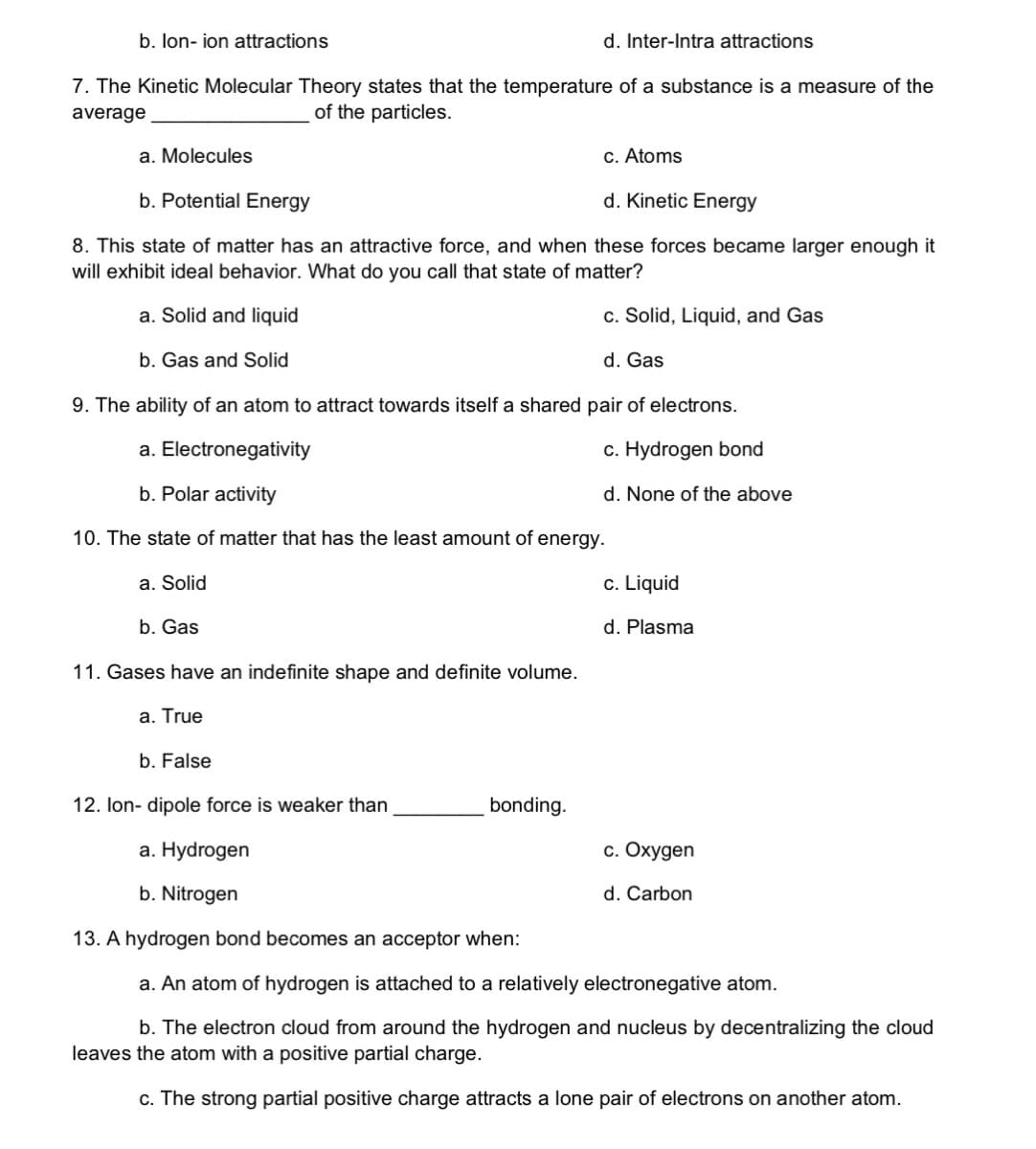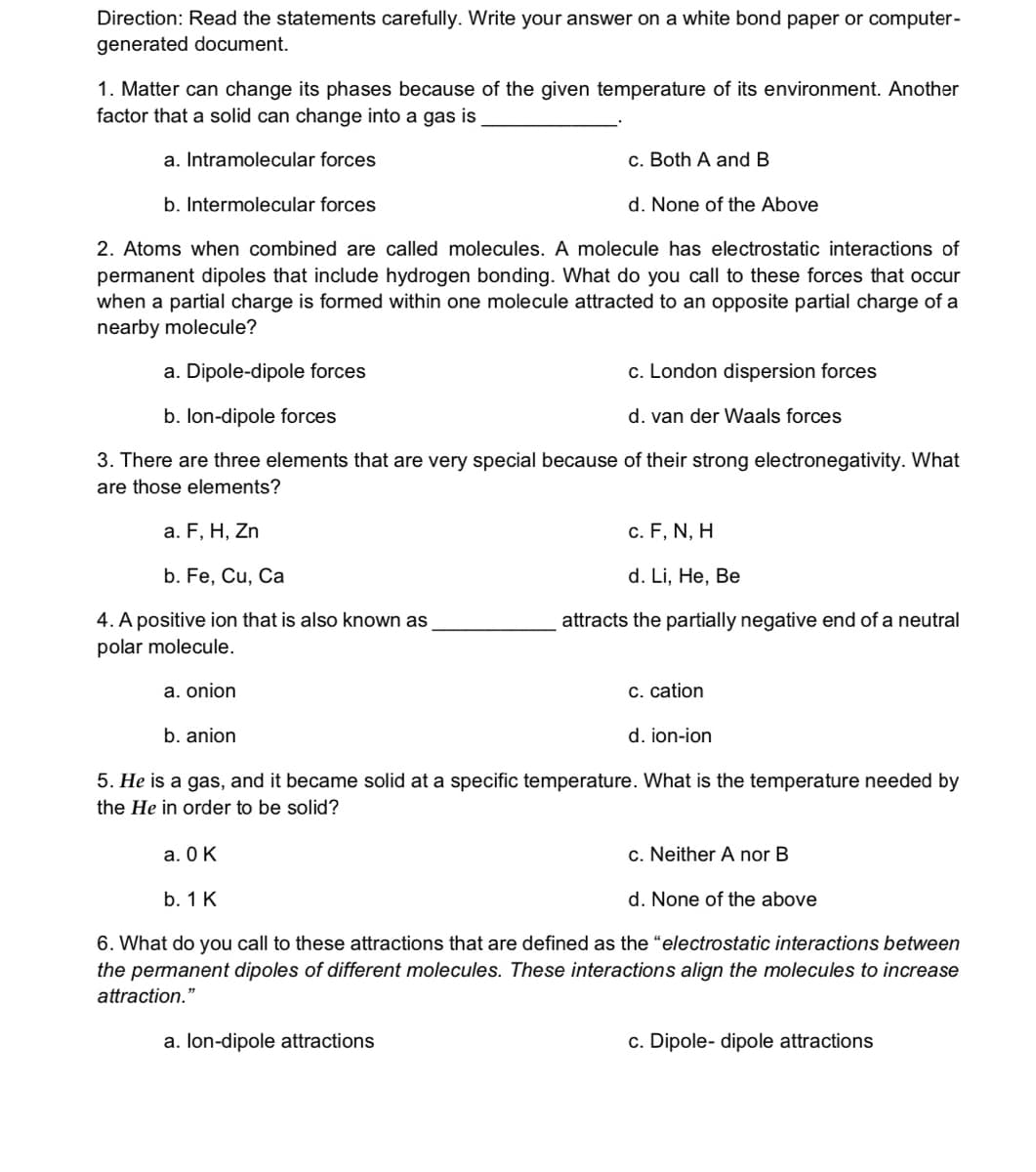Ion attractions suonaemp enul-a 7. The Kinetic Molecular Theory states that the temperature of a substance is a measure of the average of the particles. a. Molecules C. Atoms b. Potential Energy d. Kinetic Energy 8. This state of matter has an attractive force, and when these forces became larger enough it will exhibit ideal behavior. What do you call that state of matter? a. Solid and liquid c. Solid, Liquid, and Gas b. Gas and Solid d. Gas 9. The ability of an atom to attract towards itself a shared pair of electrons. a. Electronegativity c. Hydrogen bond b. Polar activity d. None of the above 10. The state of matter that has the least amount of energy. a. Solid c. Liquid b. Gas d. Plasma 11. Gases have an indefinite shape and definite volume. a. True b. False
Ion attractions suonaemp enul-a 7. The Kinetic Molecular Theory states that the temperature of a substance is a measure of the average of the particles. a. Molecules C. Atoms b. Potential Energy d. Kinetic Energy 8. This state of matter has an attractive force, and when these forces became larger enough it will exhibit ideal behavior. What do you call that state of matter? a. Solid and liquid c. Solid, Liquid, and Gas b. Gas and Solid d. Gas 9. The ability of an atom to attract towards itself a shared pair of electrons. a. Electronegativity c. Hydrogen bond b. Polar activity d. None of the above 10. The state of matter that has the least amount of energy. a. Solid c. Liquid b. Gas d. Plasma 11. Gases have an indefinite shape and definite volume. a. True b. False
Introductory Chemistry: An Active Learning Approach
6th Edition
ISBN:9781305079250
Author:Mark S. Cracolice, Ed Peters
Publisher:Mark S. Cracolice, Ed Peters
Chapter15: Gases,liquids, And Solids
Section: Chapter Questions
Problem 15.2TC
Related questions
Question

Transcribed Image Text:b. lon- ion attractions
d. Inter-Intra attractions
7. The Kinetic Molecular Theory states that the temperature of a substance is a measure of the
average
of the particles.
a. Molecules
c. Atoms
b. Potential Energy
d. Kinetic Energy
8. This state of matter has an attractive force, and when these forces became larger enough it
will exhibit ideal behavior. What do you call that state of matter?
a. Solid and liquid
c. Solid, Liquid, and Gas
b. Gas and Solid
d. Gas
9. The ability of an atom to attract towards itself a shared pair of electrons.
a. Electronegativity
c. Hydrogen bond
b. Polar activity
d. None of the above
10. The state of matter that has the least amount of energy.
a. Solid
c. Liquid
b. Gas
d. Plasma
11. Gases have an indefinite shape and definite volume.
a. True
b. False
12. lon- dipole force is weaker than
bonding.
a. Hydrogen
c. Oxygen
b. Nitrogen
d. Carbon
13. A hydrogen bond becomes an acceptor when:
a. An atom of hydrogen is attached to a relatively electronegative atom.
b. The electron cloud from around the hydrogen and nucleus by decentralizing the cloud
leaves the atom with a positive partial charge.
c. The strong partial positive charge attracts a lone pair of electrons on another atom.

Transcribed Image Text:Direction: Read the statements carefully. Write your answer on a white bond paper or computer-
generated document.
1. Matter can change its phases because of the given temperature of its environment. Another
factor that a solid can change into a gas is
a. Intramolecular forces
c. Both A and B
b. Intermolecular forces
d. None of the Above
2. Atoms when combined are called molecules. A molecule has electrostatic interactions of
permanent dipoles that include hydrogen bonding. What do you call to these forces that occur
when a partial charge is formed within one molecule attracted to an opposite partial charge of a
nearby molecule?
a. Dipole-dipole forces
c. London dispersion forces
b. lon-dipole forces
d. van der Waals forces
3. There are three elements that are very special because of their strong electronegativity. What
are those elements?
a. F, H, Zn
c. F, N, H
b. Fe, Cu, Ca
d. Li, He, Be
4. A positive ion that is also known as
attracts the partially negative end of a neutral
polar molecule.
a. onion
C. cation
b. anion
d. ion-ion
5. He is a gas, and it became solid at a specific temperature. What is the temperature needed by
the He in order to be solid?
a. 0 K
c. Neither A nor B
b. 1 K
d. None of the above
6. What do you call to these attractions that are defined as the "electrostatic interactions between
the permanent dipoles of different molecules. These interactions align the molecules to increase
attraction."
a. lon-dipole attractions
c. Dipole- dipole attractions
Expert Solution
This question has been solved!
Explore an expertly crafted, step-by-step solution for a thorough understanding of key concepts.
Step by step
Solved in 2 steps with 1 images

Knowledge Booster
Learn more about
Need a deep-dive on the concept behind this application? Look no further. Learn more about this topic, chemistry and related others by exploring similar questions and additional content below.Recommended textbooks for you

Introductory Chemistry: An Active Learning Approa…
Chemistry
ISBN:
9781305079250
Author:
Mark S. Cracolice, Ed Peters
Publisher:
Cengage Learning

Introductory Chemistry: A Foundation
Chemistry
ISBN:
9781337399425
Author:
Steven S. Zumdahl, Donald J. DeCoste
Publisher:
Cengage Learning

World of Chemistry, 3rd edition
Chemistry
ISBN:
9781133109655
Author:
Steven S. Zumdahl, Susan L. Zumdahl, Donald J. DeCoste
Publisher:
Brooks / Cole / Cengage Learning

Introductory Chemistry: An Active Learning Approa…
Chemistry
ISBN:
9781305079250
Author:
Mark S. Cracolice, Ed Peters
Publisher:
Cengage Learning

Introductory Chemistry: A Foundation
Chemistry
ISBN:
9781337399425
Author:
Steven S. Zumdahl, Donald J. DeCoste
Publisher:
Cengage Learning

World of Chemistry, 3rd edition
Chemistry
ISBN:
9781133109655
Author:
Steven S. Zumdahl, Susan L. Zumdahl, Donald J. DeCoste
Publisher:
Brooks / Cole / Cengage Learning

Principles of Modern Chemistry
Chemistry
ISBN:
9781305079113
Author:
David W. Oxtoby, H. Pat Gillis, Laurie J. Butler
Publisher:
Cengage Learning

Chemistry: Matter and Change
Chemistry
ISBN:
9780078746376
Author:
Dinah Zike, Laurel Dingrando, Nicholas Hainen, Cheryl Wistrom
Publisher:
Glencoe/McGraw-Hill School Pub Co

Chemistry & Chemical Reactivity
Chemistry
ISBN:
9781133949640
Author:
John C. Kotz, Paul M. Treichel, John Townsend, David Treichel
Publisher:
Cengage Learning